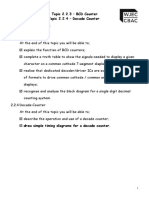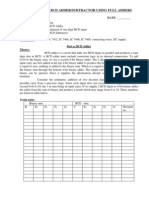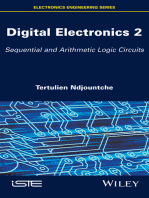LCST Experiment 1. Number Systems
LCST Experiment 1. Number Systems
Uploaded by
FerrolinoLouieCopyright:
Available Formats
LCST Experiment 1. Number Systems
LCST Experiment 1. Number Systems
Uploaded by
FerrolinoLouieOriginal Title
Copyright
Available Formats
Share this document
Did you find this document useful?
Is this content inappropriate?
Copyright:
Available Formats
LCST Experiment 1. Number Systems
LCST Experiment 1. Number Systems
Uploaded by
FerrolinoLouieCopyright:
Available Formats
EXPERIMENT I
NUMBER SYSTEM
I. OBJECTIVE
To convert of decimal number systems to BCD.
II. BASIC CONCEPTS
A number system simply consists of a set of numbers. However, to be properly categorized
as a number system, the numbers in the group must follow a particular pattern or meet sets
of criteria.
There are two states to represent quantities in digital systems and all are binary in nature.
The binary system has a base and binary digit is often called a bit, it is either 0 (Low) and
(High).
The octal number system uses base of 8 and digits 0 through 7. The binary is converted to
octal by arranging the binary number in groups of 3 bits, starting at the binary point and
writing the octal symbol for each binary group.
The hexadecimal system uses base of 16 and uses 16 characters. Composing of numbers
from 0 through 9 and letters A through F. The binary is converted to hexadecimal by
arranging the binary number in groups of 4 bits, starting at the binary point and writing the
hex symbol for each binary group.
The BCD system uses 4 bits to represent each decimal digit. A 4-bit binary number can
represent the numbers 0 to 15, but in BCD it represents only the quantities 0 through 9 and
binary representations of the numbers 10 through 15 are considered invalid BCD.
III. MATERIALS AND EQUIPMENT
7483 IC –1
LEDs – 5
330 ohm (1/2 W) - 5
DC power supply
Connecting wires
Prepared By: MBM
IV. CIRCUIT DIAGRAM
5V
A4 C4
1 5 14
A3 3
A2 330 ohms
8
A1 10
7483
B4 9 S1
16
B3 6 S2
4
B2 S3
7 2
S4
B1 11 15
C0 13
12 330 ohms 330 ohms 330 ohms 330 ohms
Figure 1. Schematic Diagram
V. PROCEDURE
1. Implement the circuit in Figure 1 using multi sim.
2. Using initial values of A = 610 and B = 710 and Co = 0, verify the output and complete
Table 1 using the given input combinations. Use logic 0 = 0V and logic 1 = +5V
3. Convert the given decimal number to equivalent binary number.
VI. DATA
Table 1. Conversion Table
A10 B10 C10 A1 A2 A3 A4 B1 B2 B3 B4 C4 4 3 2 1
6 7 0
9 2 0
2 5 1
5 5 1
10 8 0
10 3 1
Prepared By: MBM
VII. ANALYSIS OF DATA
VIII. CONCLUSION
IX. QUESTIONS AND PROBLEMS
1. What is the function of the 330 ohm resistor in Figure 1.1?
2. How high can you count using a 4-bit numbers?
3. How many different numbers can be represented using four bits?
X. APPLICATIONS
1. Complete the Table 2 by converting the given number to each of the other number
system.
Table 2. Number Systems
Decimal Binary Octal Hexadecimal BCD
101
1011
65
1AD
01011111
2. Determine the 1’s complement of the equivalent binary numbers in table 2.2.
3. Add in binary
a. 11112= b. 11012=
+ 11012 + 11102
11112
4. Subtract in binary
a. 11012 b. 101101102
- 1112 - 10110102
Prepared By: MBM
You might also like
- Digital Fundamentals LAB #5 Binary Adders: ObjectiveDocument3 pagesDigital Fundamentals LAB #5 Binary Adders: ObjectiveAnonymous uPUm1vh4H100% (1)
- Modul Minggu Ke-2 (DB6 Dan DB7)Document14 pagesModul Minggu Ke-2 (DB6 Dan DB7)farrel prambudiNo ratings yet
- MULLARD Electronic Counting Circuits Techniques Devices 20160521-0002Document230 pagesMULLARD Electronic Counting Circuits Techniques Devices 20160521-0002wail pastorelloNo ratings yet
- Tutorial 4 2Document5 pagesTutorial 4 2Fadhila AzianNo ratings yet
- Repaso 1Document5 pagesRepaso 1Hector GasgaNo ratings yet
- EIE418 Module2Document69 pagesEIE418 Module2zozoking 101No ratings yet
- Chapter 5Document39 pagesChapter 5UMMU MARDHIAH ABDUL HALIMNo ratings yet
- Assingnment# 1Document8 pagesAssingnment# 1Tayyab AbbasNo ratings yet
- Digital Electronics: 1. Number System & Codes 2. Binary Airthmetic 3. Logic GatesDocument10 pagesDigital Electronics: 1. Number System & Codes 2. Binary Airthmetic 3. Logic Gatesrajitha chowdaryNo ratings yet
- ADEC LabDocument16 pagesADEC LabPraveen TPNo ratings yet
- Digital Electronics All Formulas 1706089628Document27 pagesDigital Electronics All Formulas 17060896287mrjfxp9tfNo ratings yet
- EEE211L - Lab 5 - Binary ArithmeticDocument6 pagesEEE211L - Lab 5 - Binary ArithmeticMd KaiumNo ratings yet
- Object CounterDocument39 pagesObject CounterNARESH WALIA100% (1)
- Lab 1 - Mathematics in Computer Networking PDFDocument6 pagesLab 1 - Mathematics in Computer Networking PDFGenoschyderNo ratings yet
- Lab 4Document4 pagesLab 4KianJohnCentenoTuricoNo ratings yet
- Lecture #12Document6 pagesLecture #12Teshome GirmaNo ratings yet
- Chapter 4-Data Representation in computersDocument8 pagesChapter 4-Data Representation in computersbentiNo ratings yet
- EED206 L2 Digital Electronics Spring2021: Experiment 2 Code ConvertersDocument1 pageEED206 L2 Digital Electronics Spring2021: Experiment 2 Code ConvertersOm PandeyNo ratings yet
- TCP/IP Cheat Sheet: A Free Study Guide by Boson Software, LLCDocument13 pagesTCP/IP Cheat Sheet: A Free Study Guide by Boson Software, LLCnlmejiaNo ratings yet
- DLD BankDocument16 pagesDLD BankHarshad ThiteNo ratings yet
- AnkitDocument4 pagesAnkitankitkgupta097649No ratings yet
- WEEK-3 - CSC340 Homework 2Document3 pagesWEEK-3 - CSC340 Homework 2Daniel sNo ratings yet
- Experiment 5 BCD Adder and Comparator 1Document9 pagesExperiment 5 BCD Adder and Comparator 1Hasnain AwanNo ratings yet
- Co 2 Marks All Units Q & A Final PrintDocument10 pagesCo 2 Marks All Units Q & A Final PrintArun VijayNo ratings yet
- Digital Electronics QB 2015-RDocument8 pagesDigital Electronics QB 2015-RKeerthe VaasanNo ratings yet
- Electronics For Computing QuestionsDocument30 pagesElectronics For Computing QuestionsKaka MwenyaNo ratings yet
- 02.machine Level Representation of DataDocument60 pages02.machine Level Representation of Data2022680924No ratings yet
- Tugas 1 - 2Document6 pagesTugas 1 - 2Rizaldy Pahlevi Bin JamaluddinNo ratings yet
- Practice ProblemsDocument4 pagesPractice ProblemsSahil GautamNo ratings yet
- Week 7-15 LDDocument8 pagesWeek 7-15 LDDave FagaritaNo ratings yet
- Tutorial 1 Number System and Codes: Numbersystem&Codes / Page 1 of 2Document2 pagesTutorial 1 Number System and Codes: Numbersystem&Codes / Page 1 of 2Amirul ArifNo ratings yet
- Data Representation Homework #01 - Answers: A) 1100 B) 111010 C) 1010010 D) 10011 E) 101101Document67 pagesData Representation Homework #01 - Answers: A) 1100 B) 111010 C) 1010010 D) 10011 E) 101101Amira OkashaNo ratings yet
- Figure 3.7. Four Basic Components of The 6812 Processor.: Processor Registers Bus Interface Unit Control Address DataDocument18 pagesFigure 3.7. Four Basic Components of The 6812 Processor.: Processor Registers Bus Interface Unit Control Address DatashahanisubhashNo ratings yet
- Problem 7Document2 pagesProblem 7Abdi JoteNo ratings yet
- Tutorial QuestionsDocument30 pagesTutorial QuestionsGhana KumaranNo ratings yet
- chapter 5Document8 pageschapter 5jemalmani22No ratings yet
- Model Question PaperDocument2 pagesModel Question PaperAjay KumarNo ratings yet
- Decoders Lab TaskDocument21 pagesDecoders Lab TaskAleena MuzahirNo ratings yet
- CA Week 3 - TutorialDocument2 pagesCA Week 3 - Tutorialalexanderlouis.auNo ratings yet
- Digital ElectronicsDocument64 pagesDigital ElectronicshaalefomNo ratings yet
- Learning Objectives:: Topic 2.2.3 - BCD Counter Topic 2.2.4 - Decade CounterDocument35 pagesLearning Objectives:: Topic 2.2.3 - BCD Counter Topic 2.2.4 - Decade CountersuriantoNo ratings yet
- Digital ElectronicsDocument58 pagesDigital ElectronicsLara Mae M. BangugNo ratings yet
- IntroductionDocument37 pagesIntroductionkakakakak yayayaNo ratings yet
- Lab 1 - DLDDocument7 pagesLab 1 - DLDTarviha FatimaNo ratings yet
- Mod 1 2Document20 pagesMod 1 2Naseef RahmanNo ratings yet
- tut07qnsDocument4 pagestut07qnszkyiszkyNo ratings yet
- DSD Assessment 2Document3 pagesDSD Assessment 2hello worldNo ratings yet
- Nalla Malla Reddy Engineering College: I-Mid Examination Objective Set-A Branch: EEE Subject: DE Year /sem: II/II DateDocument6 pagesNalla Malla Reddy Engineering College: I-Mid Examination Objective Set-A Branch: EEE Subject: DE Year /sem: II/II DateDr-Asit Kumar ParidaNo ratings yet
- Digital System Simulation LabDocument4 pagesDigital System Simulation LabHafizuddin AliNo ratings yet
- EE200 Experiment 07Document5 pagesEE200 Experiment 07xanxus2012No ratings yet
- Tle-10 Ict Quarter 1 Module 1 (Babatuan)Document14 pagesTle-10 Ict Quarter 1 Module 1 (Babatuan)Shua HongNo ratings yet
- Exp10 BCDAdderDocument4 pagesExp10 BCDAddervk2you009No ratings yet
- EE-342 Digital ElectronicsDocument2 pagesEE-342 Digital ElectronicsDeepesh KumarNo ratings yet
- DP-Assignment Brief A1 - UpdatedDocument12 pagesDP-Assignment Brief A1 - UpdatedTân NguyễnNo ratings yet
- Code ConverterDocument4 pagesCode ConverterShailesh WagholeNo ratings yet
- Exploring BeagleBone: Tools and Techniques for Building with Embedded LinuxFrom EverandExploring BeagleBone: Tools and Techniques for Building with Embedded LinuxRating: 4 out of 5 stars4/5 (2)
- Physics and Technology of Crystalline Oxide Semiconductor CAAC-IGZO: Application to DisplaysFrom EverandPhysics and Technology of Crystalline Oxide Semiconductor CAAC-IGZO: Application to DisplaysNo ratings yet
- Programmable Logic Controllers: A Practical Approach to IEC 61131-3 using CoDeSysFrom EverandProgrammable Logic Controllers: A Practical Approach to IEC 61131-3 using CoDeSysNo ratings yet
- Digital Electronics 2: Sequential and Arithmetic Logic CircuitsFrom EverandDigital Electronics 2: Sequential and Arithmetic Logic CircuitsRating: 5 out of 5 stars5/5 (1)
- CET0212 Module 1Document31 pagesCET0212 Module 1FerrolinoLouieNo ratings yet
- 1458 Balagtas St. Barangay La Paz Makati Contact Number: (+63) 999-545-57-57 FB and Twitter: Apolaki AdvertisingDocument1 page1458 Balagtas St. Barangay La Paz Makati Contact Number: (+63) 999-545-57-57 FB and Twitter: Apolaki AdvertisingFerrolinoLouieNo ratings yet
- Paulo, Bill Mae - Le1.1Document3 pagesPaulo, Bill Mae - Le1.1FerrolinoLouieNo ratings yet
- Implicit Differentiation: Lesson 6.4Document11 pagesImplicit Differentiation: Lesson 6.4FerrolinoLouieNo ratings yet
- Module 1 Review On Number SystemsDocument57 pagesModule 1 Review On Number SystemsFerrolinoLouieNo ratings yet
- Pinoy: Industrial ElectronicsDocument21 pagesPinoy: Industrial ElectronicsFerrolinoLouieNo ratings yet
- Cryptoblades Tracker V2Document41 pagesCryptoblades Tracker V2FerrolinoLouieNo ratings yet
- Mechanics of Deformable Bodies Quiz 2Document4 pagesMechanics of Deformable Bodies Quiz 2FerrolinoLouieNo ratings yet
- DungeonSwap WhitePaper V0.9Document15 pagesDungeonSwap WhitePaper V0.9FerrolinoLouieNo ratings yet
- System of Equations ActivityDocument1 pageSystem of Equations ActivityFerrolinoLouieNo ratings yet
- Related Rates: By: Louielito U. Ferrolino, ECEDocument21 pagesRelated Rates: By: Louielito U. Ferrolino, ECEFerrolinoLouieNo ratings yet
- BERNARDO CompilationCPF PDFDocument39 pagesBERNARDO CompilationCPF PDFFerrolinoLouieNo ratings yet
- Adamson University College of Engineering Computer Engineering DepartmentDocument43 pagesAdamson University College of Engineering Computer Engineering DepartmentFerrolinoLouieNo ratings yet
- MDP Prob Set Shear and Moment in BeamsDocument2 pagesMDP Prob Set Shear and Moment in BeamsFerrolinoLouieNo ratings yet
- Problem Set Chapter 2: Simple StrainDocument2 pagesProblem Set Chapter 2: Simple StrainFerrolinoLouieNo ratings yet
- New GuineaDocument3 pagesNew GuineaCarl PhilipNo ratings yet
- William Quan Judge - Questions and AnswersDocument28 pagesWilliam Quan Judge - Questions and AnswerskPodNo ratings yet
- Modulo15 RiscV DDCArv Ch7Document34 pagesModulo15 RiscV DDCArv Ch7Gabriel BertolaziNo ratings yet
- Module 9 Arst and Creativity LiteracyDocument9 pagesModule 9 Arst and Creativity Literacyredilyn dela penaNo ratings yet
- Chapter 3 Functional EnglishDocument5 pagesChapter 3 Functional Englishaamirali1061aNo ratings yet
- Ifọrọwọrọ Laarin Musulumi Ati KristianiDocument58 pagesIfọrọwọrọ Laarin Musulumi Ati KristianiIslamic-invitation.com0% (1)
- Biblical Models of CommunicationDocument3 pagesBiblical Models of Communicationkiran dara100% (1)
- DS Ec300Document25 pagesDS Ec300Gianluca Pesaresi0% (1)
- WORKBOOKDocument3 pagesWORKBOOKJANETH LOPEZ MORENONo ratings yet
- Bootstrap and CSSDocument63 pagesBootstrap and CSSBhumi ranaNo ratings yet
- Getting Started With Python ProgrammingDocument1,484 pagesGetting Started With Python ProgrammingPoorna28100% (9)
- Time for Grammar - Expert - 학생용 Workbook PDFDocument76 pagesTime for Grammar - Expert - 학생용 Workbook PDFEvelyn JungNo ratings yet
- Books Published in Goa 1987Document12 pagesBooks Published in Goa 1987Frederick NoronhaNo ratings yet
- 5.control Structure II (Loop)Document23 pages5.control Structure II (Loop)Tazbir AntuNo ratings yet
- Formulation of VCO Emulsion Drink Using Emulsifier Variations (Arabic Gum, Tween 80) and WaterDocument10 pagesFormulation of VCO Emulsion Drink Using Emulsifier Variations (Arabic Gum, Tween 80) and WaterWinda RahmaningsihNo ratings yet
- Macbeth Literary Terms GlossaryDocument5 pagesMacbeth Literary Terms GlossaryJlute27100% (3)
- First Grade Singular and Plural NounsDocument11 pagesFirst Grade Singular and Plural NounsJennifer Porras DiazNo ratings yet
- DissertationDocument69 pagesDissertationWongHeiChitNo ratings yet
- Oracle 11g DBADocument5 pagesOracle 11g DBAconnect2rameshNo ratings yet
- How To Download and Install MediaTek USB VCOM Drivers - DroidWinDocument18 pagesHow To Download and Install MediaTek USB VCOM Drivers - DroidWinjoeydropkoNo ratings yet
- Soal Dan Kunci Jawaban Mata Pelajaran Bahasa Inggris Semester 1Document7 pagesSoal Dan Kunci Jawaban Mata Pelajaran Bahasa Inggris Semester 1Serendipity English100% (1)
- Testng Tutorial: Install Testng Into EclipseDocument7 pagesTestng Tutorial: Install Testng Into EclipseKavithaNo ratings yet
- Pashto Alphabet PDFDocument1 pagePashto Alphabet PDFMuhammad Ali KhanNo ratings yet
- LogtrackDocument2 pagesLogtrackNur FadilahNo ratings yet
- Adam RossDocument10 pagesAdam RossStenlyIvanMamanuaNo ratings yet
- TOEFL - Structure 5.0Document20 pagesTOEFL - Structure 5.0Adrianosvki Figuerosvki100% (11)
- Tone Words and DefinitionsDocument12 pagesTone Words and DefinitionsStory RewindNo ratings yet
- Ii Conditional IF + Past Simple +would: Put The Verbs in The Correct FormDocument2 pagesIi Conditional IF + Past Simple +would: Put The Verbs in The Correct FormANDREEA BĂLANNo ratings yet
- True BaaaDocument1 pageTrue BaaaLenard GarxiaNo ratings yet
- Revised Notice - Submission of Assignment For Frugal Testing Internship Cum PPO Recruitment Drive - 2024 Graduating BatchDocument22 pagesRevised Notice - Submission of Assignment For Frugal Testing Internship Cum PPO Recruitment Drive - 2024 Graduating BatchØmïïNo ratings yet








































































































